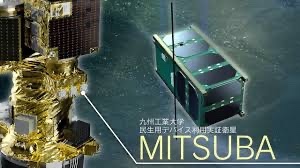
Cosmic Radiation: How Do Semiconductors Degrade?
– Investigating terrestrial semiconductors in space –
Kyushu Institute of Technology:
Kyushu Institute of Technology will install it on a microsatellite and conduct a survey
Effects of cosmic radiation:
Taking semiconductors for use on the ground into outer space.
It was decided to install it on a microsatellite and collect space data.
We developed a microsatellite for 4 million yen.
Kyushu Institute of Technology
student team
On the 6th, we unveiled the microsatellite “MITSUBA”.
10 centimeters in length and width,
It is 22 centimeters tall and
It weighs 1.7 kilograms.
On board this satellite is a semiconductor on the ground.
Faculty of Engineering, Kyushu Institute of Technology
Minami Konaka
The three large parts are the semiconductor parts that we will observe this time.
We will observe “how cosmic radiation degrades this semiconductor.”
Another mission:
“Small equipment for ground use with USB connection”.
We will investigate whether it can operate in outer space and receive data on the ground.
If we can get this data, we can develop satellites faster and cheaper.
(RKB Mainichi Broadcasting)-Yahoo! News
https://news.yahoo.co.jp/articles/a5d428446b7197c0bfea75a92d2df79ce5e62439
Rayonnement cosmique : comment les semi-conducteurs se dégradent-ils ?
– Étude des semi-conducteurs terrestres dans l’espace –
Institut de technologie de Kyushu :
L’Institut de technologie de Kyushu l’installera sur un microsatellite et mènera une enquête
Effets du rayonnement cosmique :
Emporter des semi-conducteurs pour une utilisation au sol dans l’espace extra-atmosphérique.
Il a été décidé de l’installer sur un microsatellite et de collecter des données spatiales.
Nous avons développé un microsatellite pour 4 millions de yens.
Institut de technologie de Kyushu
équipe étudiante
Le 6, nous avons dévoilé le microsatellite “MITSUBA”.
10 centimètres de longueur et de largeur,
Il mesure 22 centimètres de haut et
Il pèse 1,7 kg.
A bord de ce satellite se trouve un semi-conducteur au sol.
Faculté d’ingénierie, Institut de technologie de Kyushu
Minami Konaka
Les trois grandes parties sont les parties semi-conductrices que nous allons observer cette fois.
Nous observerons “comment le rayonnement cosmique dégrade ce semi-conducteur”.
Autre mission :
“Petit matériel à usage au sol avec connexion USB”.
Nous étudierons s’il peut fonctionner dans l’espace extra-atmosphérique et recevoir des données au sol.
Si nous pouvons obtenir ces données, nous pouvons développer des satellites plus rapidement et à moindre coût.
(RKB Mainichi Broadcasting) – Nouvelles de Yahoo!
Kosmische Strahlung: Wie zersetzen sich Halbleiter?
– Untersuchung terrestrischer Halbleiter im All –
Kyushu Institut für Technologie:
Das Kyushu Institute of Technology wird es auf einem Mikrosatelliten installieren und eine Umfrage durchführen
Auswirkungen der Höhenstrahlung:
Halbleiter für den Einsatz am Boden in den Weltraum bringen.
Es wurde beschlossen, es auf einem Mikrosatelliten zu installieren und Weltraumdaten zu sammeln.
Wir haben einen Mikrosatelliten für 4 Millionen Yen entwickelt.
Kyushu Institut für Technologie
studentisches Team
Am 6. haben wir den Mikrosatelliten „MITSUBA“ enthüllt.
10 Zentimeter in Länge und Breite,
Es ist 22 Zentimeter groß und
Es wiegt 1,7 Kilogramm.
An Bord dieses Satelliten befindet sich ein Halbleiter am Boden.
Fakultät für Ingenieurwissenschaften, Kyushu Institute of Technology
Minami Konaka
Die drei großen Teile sind die Halbleiterteile, die wir dieses Mal beobachten werden.
Wir werden beobachten, „wie kosmische Strahlung diesen Halbleiter zersetzt“.
Ein weiterer Auftrag:
“Kleingeräte für den Bodeneinsatz mit USB-Anschluss”.
Wir werden untersuchen, ob es im Weltraum operieren und am Boden Daten empfangen kann.
Wenn wir diese Daten bekommen, können wir Satelliten schneller und billiger entwickeln.
(RKB Mainichi Broadcasting) – Yahoo!-Nachrichten